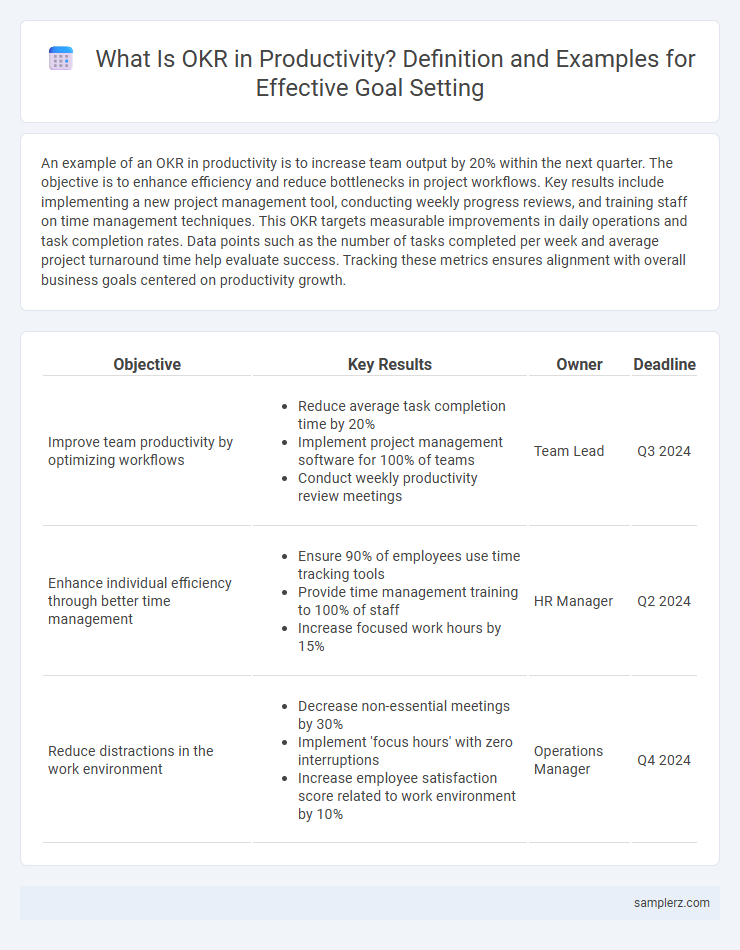An example of an OKR in productivity is to increase team output by 20% within the next quarter. The objective is to enhance efficiency and reduce bottlenecks in project workflows. Key results include implementing a new project management tool, conducting weekly progress reviews, and training staff on time management techniques. This OKR targets measurable improvements in daily operations and task completion rates. Data points such as the number of tasks completed per week and average project turnaround time help evaluate success. Tracking these metrics ensures alignment with overall business goals centered on productivity growth.
Table of Comparison
| Objective | Key Results | Owner | Deadline |
|---|---|---|---|
| Improve team productivity by optimizing workflows |
|
Team Lead | Q3 2024 |
| Enhance individual efficiency through better time management |
|
HR Manager | Q2 2024 |
| Reduce distractions in the work environment |
|
Operations Manager | Q4 2024 |
Setting Effective OKRs to Boost Productivity
Setting effective OKRs (Objectives and Key Results) to boost productivity involves defining clear, measurable goals aligned with team priorities, such as increasing project completion rates by 20% within a quarter. Key results should be specific, time-bound metrics like reducing task turnaround time from 48 to 36 hours and improving workflow automation adoption by 30%. Regular progress tracking and feedback loops ensure accountability and continuous focus on high-impact productivity initiatives.
Key Results Examples for Team Productivity
Key Results in OKRs that drive team productivity include achieving a 20% reduction in project delivery time, increasing cross-team collaboration scores by 15%, and completing 95% of sprint goals within deadlines. Tracking the number of tasks automated or streamlined to save at least 10 hours of manual work weekly enhances efficiency. Monitoring employee engagement through weekly feedback surveys with a target satisfaction score above 85% ensures sustained productivity improvements.
Personal Productivity OKR Templates
Effective Personal Productivity OKR templates often include objectives such as "Enhance Daily Focus" with key results like "Complete 90% of planned tasks each day" and "Reduce average email response time to under 2 hours." Another common OKR involves "Improve Time Management Skills," measured by "Implementing a daily time-blocking schedule for 4 consecutive weeks" and "Achieving a weekly review session every Sunday evening." These templates help track measurable improvements, fostering consistent progress and accountability in personal productivity.
Departmental OKRs for Enhanced Efficiency
Marketing department OKRs for enhanced efficiency include increasing campaign output by 20% while reducing project turnaround time by 15% over the next quarter. The sales team targets boosting lead conversion rates by 25% through improved follow-up processes and streamlined CRM usage. Operations aims to cut production downtime by 10% and optimize workflow automation to raise overall departmental productivity by 18%.
Quarterly OKR Examples for Workplace Productivity
Quarterly OKR examples for workplace productivity include Objectives such as "Increase team efficiency by 20%," paired with Key Results like "Implement time-tracking software across all departments," "Reduce meeting duration by 25% through agenda enforcement," and "Complete productivity training for 90% of employees." Another example is the Objective "Enhance remote work effectiveness," with Key Results focused on "Achieve 95% employee satisfaction in remote collaboration tools," "Establish daily stand-up meetings adhering to a 15-minute limit," and "Decrease project turnaround time by 15% in remote teams." These OKRs emphasize measurable improvements in workflow, communication, and tool utilization to drive productivity gains quarterly.
Measuring Productivity Through OKRs
OKRs in productivity often include key results such as increasing task completion rates by 20%, reducing average project turnaround time from 10 to 7 days, and improving employee output quality scores by 15%. These measurable objectives enable organizations to track progress with clear metrics, driving focused efforts and continuous improvement. Effective OKRs align individual and team activities with productivity goals, fostering accountability and data-driven performance enhancement.
Crafting Actionable Objectives for Productivity
Crafting actionable OKRs for productivity involves setting clear, measurable objectives such as increasing task completion rates by 20% within the quarter. Key results might include implementing time-tracking tools and reducing average project turnaround time by 15%. These focused targets drive continuous improvement and enhance overall work efficiency.
Cross-Functional Team OKRs on Productivity
Cross-functional team OKRs in productivity often include objectives like increasing project delivery speed by 20% and enhancing inter-departmental communication efficiency through bi-weekly sync meetings. Key results might track the reduction of task handover delays by 30% and achieving 90% adherence to sprint deadlines. These OKRs align team efforts, improve collaboration, and drive measurable productivity gains across functions.
OKR Success Stories: Productivity Edition
Google's use of OKRs significantly enhanced employee focus and output, with objectives set to improve team efficiency by 20% quarterly. Intel's implementation of OKRs drove a 30% increase in project completion rates by aligning individual goals with productivity metrics. LinkedIn's productivity OKRs helped streamline communication workflows, reducing meeting times by 25% and boosting overall team performance.
Common OKR Mistakes to Avoid for Productivity
Setting overly ambitious Objectives without clear Key Results often leads to confusion and decreased productivity. Failing to align OKRs with team priorities can cause misdirected efforts and wasted resources. Neglecting to review and adjust OKRs regularly prevents timely course corrections, reducing overall effectiveness.

example of **OKR** in **productivity** Infographic
 samplerz.com
samplerz.com